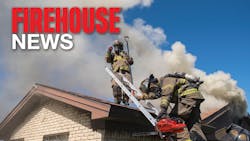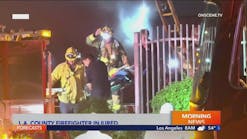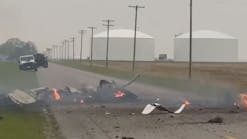NIOSH has completed three investigations into firefighter fatalities that occurred in 2018.
The probes — released Monday — involved a firefighter who perished after falling through the floor of a house fire and two in which responders suffered cardiac issues.
Nathan Flynn
On July 23, 2018, Howard County, MD, Fire Lt. Nathan Flynn was working at a house fire in Clarksville when he fell through the first floor into a basement-level crawl space.
A fellow crew member called a Mayday on the tactical channel being used for the operation, while Flynn called a Mayday and relayed pertinent information on an unmonitored channel, according to the investigation.
He was trapped for 22 minutes before being rescued by a rapid intervention crew. He was rushed to a hospital where he died.
After interviews with firefighters, investigators determined the following factors:
- Lack of crew integrity
- Lack of complete scene size-up
- Below-grade fire
- Large area residential structure
- Lack of a defined incident action plan
- Inadequate fireground communications
- Missed critical incident benchmarks
- Member operating on the wrong radio channel
- Task saturation of the incident commander
- Lack of personnel accountability
- Wind/weather
NIOSH officials also suggested the following recommendations:
- Fire departments should ensure that crew integrity is properly maintained by visual (eye-to-eye), direct (touch), or verbal (voice or radio) contact at all times when operating in an immediately dangerous to life and health (IDLH) atmosphere. The intent is to prevent firefighters from becoming lost or missing
- Fire departments should ensure incident commanders conduct a detailed scene size-up and risk assessment during initial fireground operations and throughout the incident including Side Charlie
- Fire departments should develop and implement a standard operating procedure/guideline (SOP/SOG) to identify below-grade fires and ensure that appropriate tactical operations are implemented
- Fire departments should ensure that a deployment strategy for low-frequency/high-risk incidents is developed and implemented for large area residential structures with unique architectural features
- Fire departments should ensure that incident commanders develop an incident action plan (IAP) that matches conditions encountered during initial operations and throughout the incident
- Fire departments should ensure that critical incident benchmarks and fire conditions are communicated to incident commanders throughout the incident. This is accomplished with effective fireground communications
- Fire departments should have a procedure to ensure all members operating in the hazard zone have their radios on the designated radio channel
- Fire departments should ensure all members and dispatchers are trained on the safety features of their portable radio, particularly the features useful during a Mayday
- Fire departments should develop a process to prevent task saturation of incident commanders during multi-alarm incidents
- Fire departments should ensure that the member assigned to the resource status and situation status function is not given other duties during an incident
- Fire departments should develop a formal training program that defines the job duties and functions for staff aides, incident command technicians, or staff assistants
- Fire departments should ensure incident commanders maintain control of situation status, resources status, and communications to ensure the completion of tactical objectives
- Fire departments should incorporate the principles of Command Safety into the incident management system during the initial assumption of command. This ensures that strategic-level safety responsibilities are being incorporated into the command functions throughout the incident
- Fire departments should review and/or develop SOG/SOPs to ensure that water supply is established during initial fireground operations, particularly in areas with limited or no hydrants
- Fire departments should ensure adequate staffing and deployment of resources based on the community’s risk assessment
- Fire department should periodically review and, if necessary, revise their SOP/SOG on the deployment of rapid intervention crews (RICs)
- Fire departments should use resources from the National Institute of Standards and Technology (NIST), Underwriter’s Laboratories (UL) Fire Safety Research Institute (FSRI), and the International Society of Fire Service Instructors (ISFSI) to develop and revise operational procedures on fireground tactics and provide training in fire dynamics in structures for all firefighting staff
- Fire departments should consider having all members carry a wire cutting tool
Two other investigations were initiated after firefighters succumbed to cardiac issues, one at the scene of an incident and another following a training scenario.
Danny Lister
On Sept. 1, Queen Anne-Hillsboro, MD, Vol. Fire Co. Assistant Fire Chief Daniel "Danny" Lister was "operating on the scene of a motor vehicle collision with multiple patients" when he suffered a medical emergency.
He was stricken after he helped extricate a person from the vehicle.
Lister went into cardiac arrest and was rushed into the Cath lab at University of Maryland Shore Regional Health at Easton, but he did not survive.
The cause of death was identified as hypertensive atherosclerotic cardiovascular disease.
NIOSH noted that the fire department does not require preplacement medical evaluations for applicants or offer periodic evaluations for members. They also don’t have a wellness or fitness program available.
However, if they have a serious injury or illness, they must provide a medical clearance from a physician to participate again.
To reduce the incidents of sudden cardiac events, NIOSH recommends all departments
• Ensure that all firefighters receive an annual medical evaluation consistent with NFPA 1582, Standard on Comprehensive Occupational Medical Program for Fire Departments.
• Ensure firefighters are cleared for duty by a physician knowledgeable about the physical demands of firefighting, the personal protective equipment used by firefighters, and the various components of NFPA 1582.
• Consider incident scene rehabilitation (rehab) during rescue operations as dictated by weather conditions and the work performed.
• Phase in a comprehensive wellness and fitness program for firefighters
Joshua Eugin
The same recommendations were made following an investigation of the Oct. 17 death of a 36-year-old probationary firefighter who collapsed after participating in a search and rescue training evolution.
Saint David Fire District, AZ Firefighter Joshua Eugin was in full turnout gear and SCBA for the drill.
When he fell ill and went into cardiac arrest, there were no ambulances on standby at the site. There were four transport units on duty in the county: two BLS and two ALS units. When the transport unit was requested, only one BLS unit was available, and it was approximately 25 minutes away, investigators learned.
Eugin was treated by a firefighter/medic until the ambulance arrived.
He was transported to a hospital and was pronounced dead after approximately two-and-a-half hour resuscitative efforts.
The death certificate listed the cause of death as coronary artery atherosclerosis with dilated cardiomyopathy and obesity as significant contributing conditions.
As in the previous case, NIOSH said it’s essential for departments to screen personnel prior to any strenuous activity.
Other recommendations include:
• Fire departments should have ALS with automatic external defibrillators (AEDs) and all ALS required medications on board during training exercises.
• Implement a mandatory wellness and fitness program for fire department members consistent with NFPA 1583, Standard on Health-Related Fitness Programs for Fire Department Members, and the International Association of Fire Fighters/International Association of Fire Chiefs (IAFF/IAFC) Wellness-Fitness Initiative.
• All formal training exercises, especially those involving multiple agencies, should utilize a written Incident Action Plan (IAP)

Susan Nicol | News Editor
Susan Nicol is the news editor for Firehouse.com. She is a life member and active with the Brunswick Volunteer Ambulance & Rescue Company, Oxford Fire Company and Brunswick Vol. Fire Co. Susie has been an EMT in Maryland since 1976. Susie is vice-president of the Frederick County Fire/Rescue Museum. She is on the executive committee of Frederick County Volunteer Fire and Rescue Association. She also is part of the Maryland Institute for Emergency Medical Services Systems (MIEMSS) Region II EMS Council. Susie is a board member of the American Trauma Society, Maryland Division. Prior to joining the Firehouse team, she was a staff writer for The Frederick News-Post, covering fire, law enforcement, court and legislative issues.






